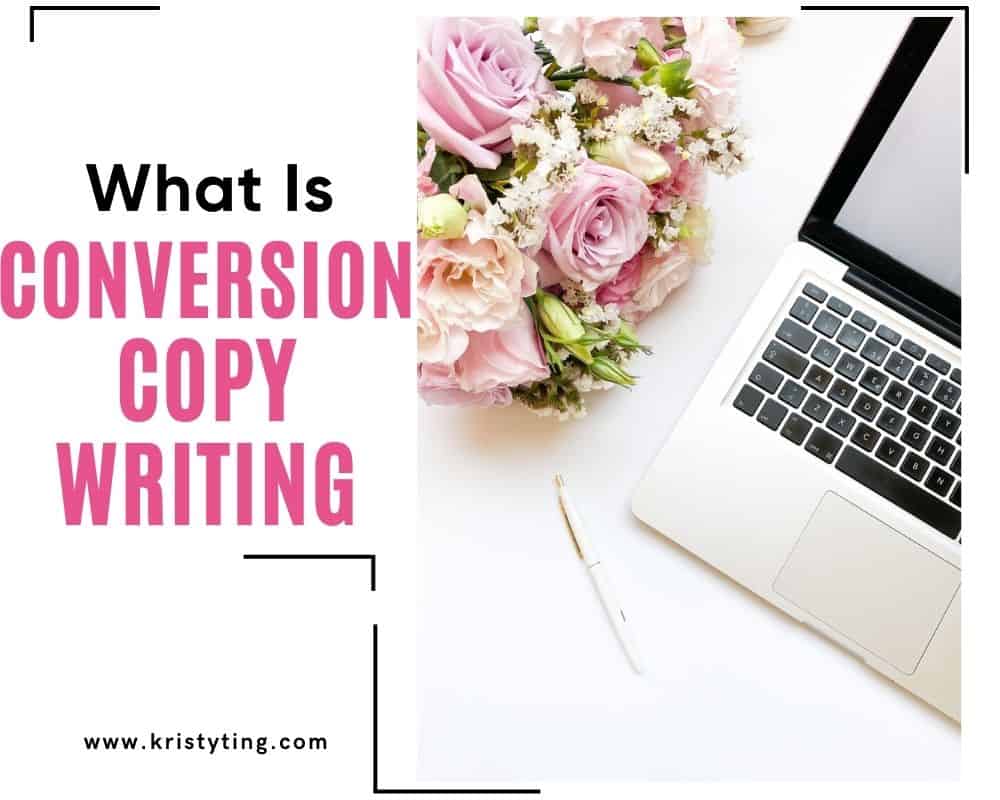This post may contain affiliate links. If you use these links to buy something we may earn a commission at no extra cost to you. Thank you for your support!
Conversion copywriting is a term that has gained significant popularity in recent years. It is a writing style that aims to persuade customers to take a specific action, such as making a purchase on a sales page, getting a free trial or signing up for a service. Conversion copywriting is a data-driven process that involves extensive research and analysis to determine what language and messaging will be most effective in driving conversions.
So what is conversion copywriting?
At its core, conversion copywriting is all about using words to motivate people to take action. It is a unique type of writing that requires a deep understanding of the target audience and their motivations. Conversion copywriters use a variety of techniques, such as emotional appeals and social proof, to create compelling messages that resonate with readers and drive them to take action.
If you are a freelance writer trying to help business owners who are looking to increase sales or grow an email list, understanding the principles of conversion copywriting is essential. By mastering this powerful writing style, you can create messages that connect with your audience on a deeper level and drive the results you are looking for.
What Is Conversion Copywriting
Defining Conversion Copywriting
Conversion copywriting is a type of persuasive writing that aims to convert website visitors into customers. It is a data-driven process that involves using words and phrases that resonate with the target audience, and that lead them to take a specific action, such as buying a product or signing up for a service. Conversion copywriting is different from other forms of copywriting because it focuses on the end goal of converting the reader into a customer.
More than ever, web pages are using conversion copywriting as part of their standard business practices.
Why Is Conversion Copywriting Important
Conversion copywriting is important because it can significantly increase a website’s conversion rate. By using the right words and phrases, a conversion copywriter can create a sense of urgency and persuade visitors to take action. This can lead to increased sales, revenue, and customer loyalty.
Goal of Conversion Copywriting
The goal of conversion copywriting is to persuade the reader to take a specific action. This action could be anything from making a purchase to signing up for a newsletter. The conversion copywriting process involves identifying the target audience, understanding their pain points, and crafting a message that resonates with them. This can involve the studying of case studies and doing in-depth research. The copywriter must also create a sense of urgency and provide a clear call-to-action.
Yes. A sales copywriter can make a lot of money.
Forms of Copywriting
Conversion copywriting is just one form of copywriting. Other forms include brand copywriting, SEO copywriting, and content marketing copywriting. Brand copywriting focuses on creating a brand voice and personality. An SEO copy involves content that is optimized for search engines. Content writing is focused on creating content that provides value to the reader and drives traffic to a website.
In summary, conversion copywriting is a process that involves using persuasive writing to convert website visitors into customers. It is important because it can significantly increase a website’s conversion rate. The goal of conversion copywriting is to persuade the reader to take a specific action, and it is just one form of copywriting among many.
The Art of Writing Conversion Copy

Let’s take a closer look at conversion copywriting.
Writing conversion copy is a skill that requires a combination of creativity and strategy. It involves crafting persuasive content that inspires readers to take action, such as making a purchase, signing up for a newsletter, or filling out a form. In this section, we’ll explore the principles, steps, and best practices of conversion copywriting.
Principles of Conversion Copywriting
The principles of conversion copywriting involve understanding your audience, identifying their pain points, and crafting a message that speaks directly to them. It’s important to use language that resonates with your target audience and makes them feel understood. Additionally, conversion copywriting involves creating a sense of urgency and scarcity to encourage readers to take action.
Steps in Writing Conversion Copy
The steps in writing conversion copy involve research, planning, and execution. The first step is to research your audience and understand their needs and pain points. Know your customer personas. What they’re feeling. What keeps them up at night. What kind of solution they truly wish for. From there, you can develop a plan for your content, including headlines, subheadings, and calls to action. Finally, you can execute your plan by writing compelling copy that speaks directly to your target audience and encourages them to take action.
Best Practices in Conversion Copywriting
There are several best practices to keep in mind when writing conversion copy. The first thing is to focus on benefits rather than features. Instead of listing the features of a product or service, focus on the benefits that it provides to the reader. Additionally, it’s always a good idea to use clear and concise language that is easy to understand.
One popular copywriting rule: Write as if you’re helping a child understand what you want to convey.
Finally, it’s important to test and optimize your copy to ensure that it is as effective as possible.
In conclusion, writing conversion copy is a complex process that requires a combination of creativity and strategy. By following these principles, steps, and best practices, you can create compelling content that inspires readers to take action and drives sales and conversions.
Here are some examples of common copy used to drive conversions.
The Role of Conversion Copy in Digital Marketing
Conversion copywriting plays a crucial role in digital marketing by creating persuasive and relevant content that drives users to take specific actions. This is also known as direct response copywriting. Digital marketers use conversion copywriting to create content that targets specific audiences, increases engagement, and ultimately drives conversions.
Conversion Copy in SEO
Conversion copywriting is an essential part of SEO copywriting, which focuses on creating content that ranks well in search results. By using conversion copywriting techniques, digital marketers can create content that not only ranks well in search engines but also drives conversions. Effective SEO copywriting involves creating content that is relevant, informative, and engaging to users while also incorporating keywords and phrases that are relevant to the topic.
Conversion Copy in Email Marketing
Conversion copywriting is also crucial in email marketing campaigns. Digital marketers use conversion copywriting to create email newsletters that are engaging, informative, and ultimately drive conversions. Effective email newsletters incorporate persuasive copy that encourages users to take specific actions, such as making a purchase or signing up for a service.
Copywriters can churn out email sequences that have the audiences looking forward to reading each and every one of them, leading to high open and click through rates.
Conversion Copy in Social Media
Conversion copywriting is also important in social media marketing. Digital marketers use conversion copywriting to create social media posts like on Facebook, that are engaging, informative, and ultimately drive conversions. Effective social media posts incorporate persuasive copy that encourages users to take specific actions, such as clicking a link or making a purchase.
In the digital world, conversion copywriting is a critical component of online marketing campaigns. By creating persuasive and relevant content that drives conversions, digital marketers can increase engagement, drive traffic to their websites, and ultimately increase revenue.
Targeting and Understanding Your Audience

To create effective conversion copywriting, it’s essential to understand the target audience. A deep understanding of the audience can help the writer craft copy that resonates with potential customers and clients.
Creating Buyer Personas
Creating buyer personas is an essential step in understanding the target audience. A buyer persona is a semi-fictional representation of the ideal customer. The persona should include information such as demographics, interests, and pain points.
Creating buyer personas can help the writer understand the target audience and create copy that speaks directly to their needs. It can also help the writer identify the language and tone that resonates with potential customers.
Identifying Pain Points
Identifying pain points is another great example when it comes to understanding your target audience. Pain points are the problems or challenges that potential customers face, that makes them worry and actively looking for a solution. By identifying pain points, the writer can create copy that speaks directly to those challenges and positions the product or service as the solution.
Conducting Market Research
Conducting market research is one of the easiest ways in understanding your target market. Market research can help the writer identify trends, understand customer behavior, and identify gaps.
Market research can include customer research, such as surveys and interviews, as well as competitor research. By conducting market research, the sales copywriter can create copy that positions the product or service in a way that resonates with potential customers and stands out from the competition.
Implementing Conversion Copywriting
When it comes to implementing conversion copywriting, there are a few key strategies that can help increase the effectiveness of your copy. Here are some tips for writing copy that converts:
Writing for Different Platforms
Different platforms require different approaches when it comes to copywriting. For example, landing pages may require shorter, more direct copy, while blog posts may allow for more storytelling and longer-form content. It’s important to understand the nuances of each platform and tailor your copy accordingly.
Creating a Sense of Urgency
One effective way to increase conversions is to create a sense of urgency in your copy. This can be achieved by using language that emphasizes scarcity, such as “limited time offer” or “only a few left in stock.” By creating a sense of urgency, you can motivate potential customers to take action and make a purchase.
Usually, this is just one single action. Offering many different actions can lead to confusion, and confusion never sells.
Therefore, landing pages will always have copy that promotes one single action – that gives your audiences the feeling that the answer to their pain lies right behind that button.
Using Social Proof
Social proof is another powerful tool for improving conversions. This can be achieved by including testimonials, reviews, and other forms of social proof in your copy. By showing that others have had positive experiences with your product or service, you can build trust and credibility with potential customers.
Ultimately, the key to effective conversion copywriting is to understand your audience and tailor your copy to their needs and desires. Whether you’re writing website copy, ad copy, or product descriptions, keeping these strategies in mind can help you create copy that converts and drives results for your business.
Conversion Copywriting Techniques and Strategies
Conversion copywriting is a data-driven approach to writing copy that is specifically designed to drive a desired action from the reader. Here are some techniques and strategies that can take your conversion-focused copywriting to the next level.
Employing a Data-Driven Approach
One of the most effective ways to improve your conversion rates is to use a data-driven approach to your copywriting. This means analyzing your data to determine what is working and what isn’t, and then using that information to craft high-quality conversion-focused copywriting that speaks directly to your target audience.
Utilizing Review Mining
Another effective technique for improving your conversion rates is to utilize review mining. This involves analyzing customer reviews and feedback to determine what your customers are looking for and what they find valuable. By understanding your customers’ needs and preferences, you can craft copy that speaks directly to them and encourages them to take action.
Crafting Effective CTAs
Crafting effective CTAs (calls-to-action) is another essential strategy for improving your conversion rates. A good CTA should be clear, concise, and compelling, using a single word or phrase that encourages the reader to take a specific action. By utilizing a data-driven approach and review mining, you can craft CTAs that are tailored to your target audience and are highly effective at driving conversions.
In summary, conversion copywriting is all about crafting high-quality, conversion-focused copy that is specifically designed to drive a desired action from the reader. By employing a data-driven approach, utilizing review mining, and crafting effective CTAs, you can take your conversion-focused copywriting to the next level and improve your conversion rates.
Copywriting Frameworks
Copywriting frameworks are a set of guidelines that copywriters use to structure their writing and create compelling content. These frameworks help copywriters identify the key components of their message and organize them in a way that resonates with their target audience. Here are some of the most common copywriting frameworks:
AIDA
AIDA stands for Attention, Interest, Desire, and Action. This framework is one of the oldest and most widely used in copywriting. It is based on the idea that a successful piece of copy must grab the reader’s attention, generate interest, create desire, and finally, lead the reader to take action. Here’s how it works:
- Attention: The headline or opening sentence should grab the reader’s attention and make them want to keep reading.
- Interest: The copy should build interest by highlighting the benefits of the product or service being offered.
- Desire: The copy should create desire by describing how the product or service can solve the reader’s problems or fulfill their desires.
- Action: The copy should end with a clear call to action, telling the reader what they need to do next.
PAS
PAS stands for Problem, Agitate, Solve. This framework is particularly effective when you’re trying to sell a product or service that solves a specific problem. Here’s how it works:
- Problem: The copy should start by identifying the reader’s problem and how it’s affecting them.
- Agitate: The copy should then agitate the problem by highlighting the negative consequences of not solving it.
- Solve: Finally, the copy should offer a solution to the problem and explain how the product or service can solve it.
ACCA
ACCA stands for Awareness, Comprehension, Conviction, Action. This framework is useful for copy that is intended to educate the reader about a new concept or idea. Here’s how it works:
- Awareness: The copy should start by creating awareness of the problem or opportunity.
- Comprehension: The copy should then help the reader understand the problem or opportunity in more detail.
- Conviction: The copy should build conviction by providing evidence and social proof that the solution being offered works.
- Action: Finally, the copy should end with a clear call to action, telling the reader what they need to do next.
AIDCA
AIDCA stands for Attention, Interest, Desire, Conviction, Action. This framework is similar to AIDA, but it includes an additional step for building conviction. Here’s how it works:
- Attention: The headline or opening sentence should grab the reader’s attention and make them want to keep reading.
- Interest: The copy should build interest by highlighting the benefits of the product or service being offered.
- Desire: The copy should create desire by describing how the product or service can solve the reader’s problems or fulfill their desires.
- Conviction: The copy should build conviction by providing evidence and social proof that the solution being offered works.
- Action: Finally, the copy should end with a clear call to action, telling the reader what they need to do next.
Overall, these frameworks provide a useful starting point for copywriters looking to create effective copy. By following these guidelines, copywriters can structure their writing in a way that resonates with their target audience and leads to increased conversions.
The Impact of Conversion Copywriting

Conversion copywriting has a significant impact on the success of any business. By creating data-driven copy that resonates with the target audience, conversion copywriting can improve conversion rates, boost sales funnels, and result in positive outcomes for the business.
Improving Conversion Rates
Conversion rates are the percentage of website visitors who take a desired action, such as making a purchase or filling out a contact form. Conversion copywriting can significantly improve conversion rates by creating copy that speaks to the needs and desires of the target audience.
Through thorough research and analysis, conversion copywriters create copy that resonates with the target audience, addressing their pain points and providing solutions to their problems. By doing so, conversion copywriting can increase the likelihood that visitors take the desired action, resulting in higher conversion rates.
Boosting Sales Funnels
Sales funnels are the process that a potential customer goes through before making a purchase. By creating copy that speaks to the needs and desires of the target audience at each stage of the sales funnel, conversion copywriting can significantly boost sales funnels.
Through research and analysis, conversion copywriters can identify the pain points and desires of the target audience at each stage of the sales funnel. By creating copy that speaks to these needs and desires, conversion copywriting can guide potential customers through the sales funnel, resulting in more sales and higher revenue for the business.
Overall, conversion copywriting can have a significant impact on the success of a business. By improving conversion rates, boosting sales funnels, and delivering positive results, conversion copywriting can help businesses achieve their goals and reach their full potential.
Conclusion
In conclusion, conversion copywriting is a vital tool for digital marketers who want to drive conversions and grow their businesses. The ultimate goal of any conversion copywriting is to persuade the prospect, subscriber, or visitor to say yes to the offer. A great conversion copywriter knows how to move the reader to ‘yes’, converting them to paid users and subscribers.
The best way to achieve this is by creating compelling copy that hones in on a single goal. This type of copywriting uses familiar words, phrases, and value propositions to convince readers to take action. Whether it’s through landing pages, product descriptions, ads, or other calls-to-action (CTAs), the copy must be persuasive and compelling.
To create great copy, a copywriter must understand the target audience and use persuasive techniques to craft messaging that resonates with readers. They must also be able to identify the pain points of the audience and provide solutions to their problems.
In summary, conversion copywriting is a data-driven process that requires a clear understanding of the target audience, a compelling value proposition, and a single goal. A great conversion copywriter can create copy that persuades readers to take action and convert them into paying customers.
Related: Ad conversion copywriting examples
Frequently Asked Questions
What are the key principles of conversion copywriting?
Conversion copywriting involves several principles, including understanding the target audience, creating a clear value proposition, using persuasive language, and focusing on benefits instead of features. Additionally, conversion copywriting involves using data and research to inform the copywriting process, testing and optimizing copy, and creating a sense of urgency to encourage action.
How can conversion copywriting improve my website’s performance?
Conversion copywriting can improve website performance by increasing conversions, such as sign-ups, purchases, or downloads. By using persuasive language and focusing on benefits, conversion copywriting can encourage visitors to take action. Additionally, conversion copywriting can improve website engagement and reduce bounce rates by creating a clear value proposition and addressing visitor pain points.
What are some successful conversion copywriting examples?
Successful conversion copywriting examples include headlines that grab attention, clear and concise value propositions, persuasive calls-to-action, and social proof, such as customer reviews or endorsements. Additionally, successful conversion copywriting often involves creating a sense of urgency, such as limited-time offers or scarcity messaging.
What skills are required to become a successful conversion copywriter?
To become a successful conversion copywriter, one must have strong writing skills, an understanding of marketing and consumer psychology, and the ability to use data and research to inform the copywriting process. Additionally, a successful conversion copywriter must be able to test and optimize copy, understand website design and user experience, and have a strong understanding of SEO.
An SEO content writer typically makes the most money – SEO is a long and hard game to play. Being good at SEO will require you to take up a SEO learning course on top of a copywriting course.
You’ll technically be a service provider, and how much you can charge will depend largely on your written skills, years of experience and other requirements that your potential client may want to see. Most skilled conversion copywriters who have been doing this for a while will have a business website and a home page that showcases their talents and testimonials from past clients.
What is the difference between conversion copywriting and traditional copywriting?
Traditional copywriting focuses on creating engaging and informative content, whereas conversion copywriting focuses on creating persuasive content that encourages action. Traditional copywriting often involves longer-form content, such as blog posts or articles, whereas conversion copywriting often involves shorter-form content, such as headlines, calls-to-action, or landing pages.
What are the benefits of hiring a conversion copywriter for my business?
Hiring a conversion copywriter can benefit your business by improving website performance, increasing conversions, and reducing bounce rates. Additionally, a conversion copywriter can help create a clear value proposition, address visitor pain points, and create a sense of urgency to encourage action. A conversion copywriter can also help test and optimize copy to improve performance over time.





